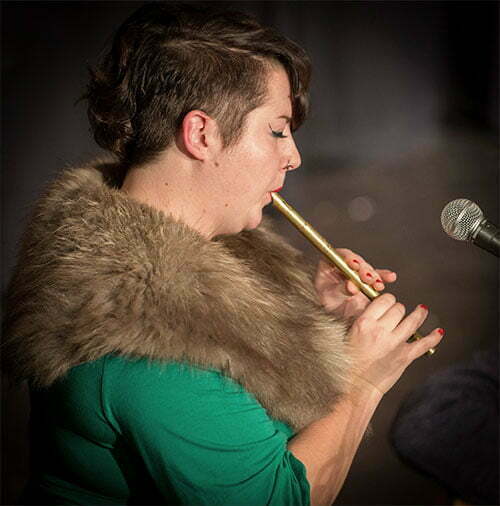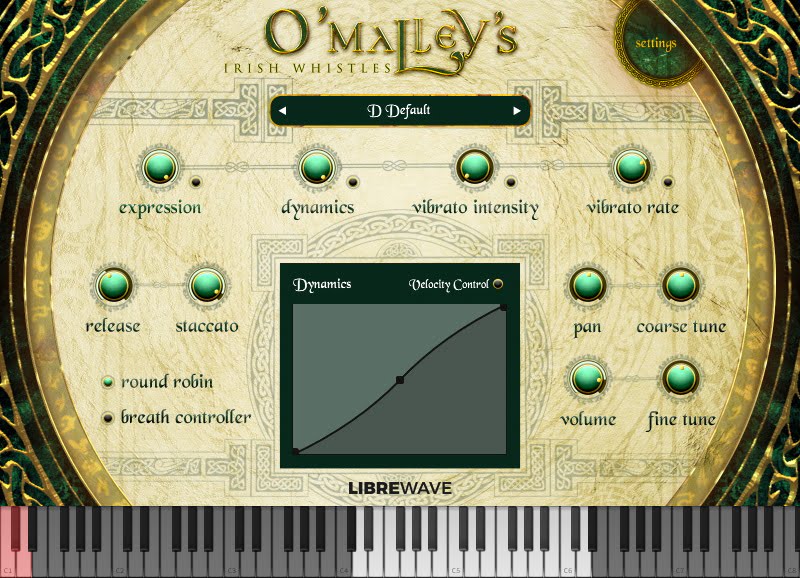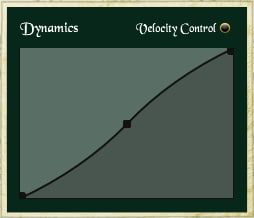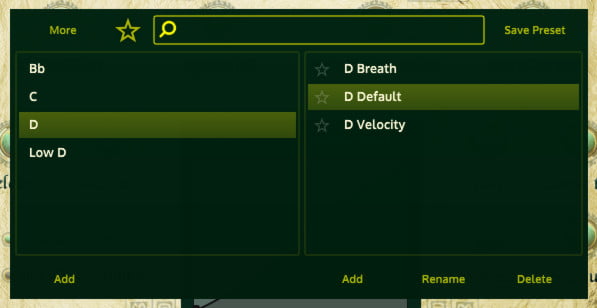O’Malley’s Irish Whistles User Guide
Tin whistle, penny whistle, English flageolet, tin flageolet, Belfast Hornpipe, feadóg stáin, and of course Irish whistle are just some of the many names given to the traditional Celtic fipple flutes.
O’Malley’s Irish Whistles includes D, C, Bb, and Low D whistle sample sets. This library was recorded in the same studio as Michaela’s Harp.
Musician

Mimi O’Malley is a multi-instrumentalist singer-songwriter. She has toured internationally with various bands, playing many styles and genres in a wide variety of ensembles.
After many years of playing Irish whistle in pubs and working through her clarinet and saxophone grades she gained a place at Chethams School of Music where she studied under James Muirhead (Halle Orchestra) and Joanna Patton (Liverpool Philharmonic).
She continues to travel and perform in venues small and large and is currently working on a solo album.
Installation
All Libre Wave virtual instruments and effects follow the same installation procedure. Please see the detailed installation guide for instructions on how to setup this product on your system.
Interface

- Hold down ctrl or cmd to increase precision when you move a knob or slider.
- You can double click a knob or slider to reset it to its default value.
- When you move a knob or slider with your mouse its value will be displayed.
- If you hold the shift key while clicking on a knob or slider an input box will be displayed where you can enter a specific value.
Automation
To use MIDI learn to link a continuous controller (CC) to a knob or slider:
- Right click the control.
- Select MIDI learn.
- Move a hardware knob, wheel, or fader to assign it to the control.
Many of the knobs have default CC assignments. You can view all CC assignments in the MIDI Automation tab of the Settings window. This is explained in more detail later in this guide.
You can remove CC assignments, including those assigned by default, by right-clicking the control and selecting Remove CC.
Many of the on-screen controls will respond to automation within your DAW without needing to assign a CC to them first. Check your DAW’s user guide for details on how to access automatable parameters.
Keyboard Layout

- The playable range of the currently loaded instrument is illuminated on the keyboard.
- Grey keys are outside of the playable range and produce no sound.
- Key switches (used for changing articulation) are coloured red and will always be positioned outside of the instrument’s playable range.
Articulations
You can select an articulation by triggering a key switch or sending a UACC continuous controller message. Changing articulation using UACC (Universal Articulation Controller Channel) is done by setting a value on MIDI CC32.
| Name | Description | Key switch | UACC/Program |
| Live | Monophonic with legato, staccato overlay, and retrigger. | C1 | 20 |
| Sustain | Polyphonic sustained notes | C#1 | 1 |
| Staccato | Polyphonic short notes | D1 | 40 |
Round Robin

The live and sustain articulations include two recorded repetition samples. The staccato articulation and legato transitions use four recorded repetitions in a true-random pattern.
Live Techniques
The Live articulation is designed to be performed in real time and contains a few features to make obtaining a realistic performance easier and more natural for a keyboard player.
Using a breath controller

When the breath controller button is enabled the Live articulation’s breath controller mode will be engaged. In this mode no sound will be triggered unless the Dynamics knob is at a value greater than 10. If the knob’s value drops below 10 any notes that are playing will be stopped. You will probably want to assign your breath controller to the Dynamics knob.
Long notes
Holding down a key will sustain a note indefinitely. Every sample will loop so you can maintain a note of any length. For a realistic performance you should try and keep in mind how much air the player would be using to hold the note and stop when appropriate.
You can use the continuous controller assigned to dynamics to create swells, crescendos, diminuendos, or any other dynamic expressions. A breath controller, mod-wheel, or expression pedal is perfect for this.
Short notes
To play a short note just release the key earlier and the note will be shorter. Play the note at a higher velocity with a brief swell on the dynamics controller to create a punchy staccato note. Using more or less force, releasing the key earlier or later, and varying the dynamics can create a variety of short articulations.
Attack and accents
Playing very softly, with a velocity below 20, will trigger a slower attack, a velocity above 20 but below 70 will trigger a normal attack.
When playing at velocities of 70 or above a staccato overlay sample will be triggered first and blended smoothly into the start of the sustain sample.
Legato
Playing in an overlapped style, holding one note while playing the next, will trigger a legato transition between the notes. You don’t need to worry about pacing your playing to get a smooth transition or to compensate for lag, the instrument will detect your playing speed, the pressure you’re using on the keys (velocity), and a few other parameters to calculate each transition.
Glides
Glissandi, slides, portamento, and smears can be triggered by pressing one key while another is already held and the sustain pedal (or other controller assigned to CC64) is engaged. This method functions between two notes up to a whole step apart.
Same note legato
A sustain pedal (or other controller assigned to CC64) can be used to trigger a legato transition on a single note. When the sustain pedal is held down any key that is released will be retriggered. Releasing the sustain pedal will end the note.
If you want to trigger a same note legato transition immediately after a glide you need to release the sustain pedal at the end of the glide and then hold it down again before releasing the key to retrigger the note.
Trills
Trills of any interval, duration, or tempo can be played in a very natural fashion using the built-in retrigger feature. Hold down the first note of the trill while pressing and releasing the second. This is especially realistic when the library is used in combination with a breath controller linked to dynamics.
Chords
Although the instruments in this library are monophonic it is sometimes useful to be able to play two or more notes at once. The Live articulation has a built in chord detector that will attempt to differentiate between a legato transition and playing a chord. There is no guarantee that it will be accurate 100% of the time. If you try to play a chord but only one note sounds it means the system thought you were trying to play a legato transition. This feature should be used sparingly and is included as a tool for composing rather than for crafting a realistic performance.
Performance Controls

Velocity
When using the Live articulation the note-on velocity controls the attack of each note. Playing a low velocity will create a longer attack and a high velocity will produce a shorter attack.
Velocity can also be used to control the initial Dynamic of a note. To activate this functionality you need to enable the small round button next to the Dynamics knob. This will cause the Velocity Control button to be displayed which you can then activate.
Expression
The expression control provides an overall volume change to the instrument. This can be used in conjunction with the dynamics controller to customise the dynamic range of the instrument or create niente diminuendos.
Dynamics
The dynamics controller allows you to smoothly change the instrument’s dynamic. A volume change is also applied automatically by this controller to keep the dynamics consistent and realistic across the range of the instrument. Like all fipple flutes the playable dynamics of the Irish Whistle are limited and vary across the range of the instrument, generally low notes are soft and high notes are loud.
Vibrato Intensity & Rate
The vibrato intensity knob controls the amount of vibrato. The vibrato rate knob controls the speed of the vibrato. A lower value will produce a slower vibrato while a higher value creates a faster vibrato.
Pitch Bend Wheel
All of the whistles in this library respond to the pitch bend controller. This is a great way to play simple slides into and out of notes in real-time.
Response Curves

Next to each performance control knob is a small button which when enabled will display the response curve for that control. If none of the buttons are enabled the response curve for velocity will be displayed.
You can edit the response curve to adjust the control’s sensitivity.
Master Output

The master output controls allow you to adjust the sound of the instrument after any sonic changes created by the other controls.
- Pan: This controls the left/right balance of the instrument.
- Volume: Provides the final stage of the instrument’s volume control. It can also provide a gain boost of up to +3dB at its highest setting.
- Coarse: tune Tuning control in the range of -12 to +12 semitones.
- Fine tune: Tuning control in the range of -100 to +100 cents.
Preset Browser


You access the preset browser by clicking the name of the currently loaded preset which is displayed on the main interface. The arrow buttons on either side can be used to load the previous or next preset.
The browser itself is divided into two columns allowing you to select a preset based on the type of whistle. You can create your own presets by clicking the Add button below the second column.
Clicking the More button will open a drop down menu offering you a number of options for importing and exporting your presets.

You can filter the list of presets by typing in the search bar and hitting enter.
Clicking the star icon next to a preset will add it to your favourites list, clicking it again will remove it from your favourites. You can see all your favourites by clicking the larger star icon next to the search box above the first column of the preset browser.
You can save any changes you’ve made to a preset by clicking the Save Preset button next to the search bar.
Settings

The settings screen gives you control over the sampler engine, hardware configuration, and MIDI options. The settings that are available will vary slightly depending on if you are using the standalone instrument or the plugin.
Engine Tab:
- Standalone application only
- Driver: This is used to set the audio playback system that the instrument will use. The choice of drivers will vary depending on your operating system.
- Audio Device: You can select which hardware audio output device (soundcard/audio interface) you want the instrument to use.
- Output: If your chosen device has multiple outputs you can use this menu to select which will be used by the instrument.
- Buffer Size: This is the buffer used by your chosen audio device. Lowering the buffer size reduces latency but if it’s too low it can cause pops and clicks to be heard.
- Sample Rate: This is the sample rate of your chosen audio device. The available options will vary based on your hardware.
- Standalone application and plugin
- UI Zoom Factor: You can increase or decrease the size of the instrument’s interface using the options in this menu. All of the instrument’s graphics and text are designed to scale perfectly without blurring or fuzziness.
- Streaming Mode: Select the option that suits the type of drive you are using to store the instrument’s samples.
- Max Voices: The amount of polyphony the instrument can handle. If the value is too low you may notice some dropouts when playing a lot of notes.
- Clear MIDI CC: Use this button to reset all MIDI continuous controller assignments you have made using the MIDI learn feature.
- Change sample folder location: If you move the samples to a new location you can use this button to point the instrument to them.
MIDI input tab: Displays the hardware MIDI devices that the instrument can see. You can check the boxes alongside the device names to enable those devices for MIDI input. This tab is only visible in the standalone application
MIDI channel tab: From here you can select the incoming MIDI channels that the instrument will respond to.
MIDI automation tab: Displays information about any MIDI continuous controller numbers you have assigned using the MIDI learn feature. It also allows you to adjust the range of values that the continuous controllers will use and provides you with a quick way to invert the values if desired.
About tab: Shows information about the plugin. If you ever require assistance with the plugin it’s a good idea to provide its version number which you’ll be able to find in this tab.
Acknowledgements
Studio: Riverside
Recording Technician: Sarah McNeill
Musician: Mimi O’Malley
Editing & Scripting: David Healey
Graphic Design: Koke Núñez Gómez
IDE: HISE

